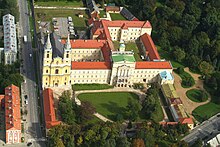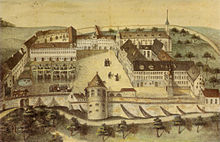abbey

An abbey (from Latin abbatia ) is a monastery which is regularly headed by an abbot or an abbess.
Abbeys
Usually only the monastic orders and regular canons of the Catholic Church own monasteries with the rank of an abbey. The St. Thomas Abbey in Old Brno the Augustinians (OSA) is an exception . Those provosts of the Canon Regulars, which are presided over by an infuled provost, are legally equal to the abbeys.
For the Holy See to elevate a monastery to an abbey , certain canon law requirements must be met (e.g. a certain minimum number of monks or nuns ). If a monastery is raised to the rank of an abbey, the convent can elect an abbot or an abbess.
The abbot and the abbess not receive sacramental ordination , but when it was set into office a Abtsbenediktion which is colloquially referred to as "ABTS or Äbtissinnenweihe".
Abbeys with a prominent canonical position
Particularly important abbeys, often the ancestral monasteries of a Benedictine congregation, also bear the title of archabbey ; in Austria the Archabbey of St. Peter and in Germany the Archabbeys of Beuron and St. Ottilien . The head of an archabbey is an archabbot .
Within the Cistercian order those monasteries are called primary abbeys that were founded by the original monastery of the Cistercians Citeaux as the first four daughter monasteries.
As a rule, the abbeys are not subject to the bishop responsible for the area, but directly to the Holy See . A few abbeys form their own diocese . In these territorial abbeys , the abbot has the jurisdiction of a bishop over the territory of the abbey. A consecration violence does not come to him. In recent years, however, these territorial abbeys have been severely curtailed, so that although they are still regarded as such, they usually only own the parish of the abbey itself.
Imperial abbeys and prince abbeys
In the Holy Roman Empire of the German Nation, abbeys that were directly subordinate to the emperor were called imperial abbeys .
A prince abbey was an abbey with rights of a principality and a prince abbot as ruler, e.g. B. the Abbey of Prüm .
Priories
A branch of these orders that does not have the rank of an abbey is called a priory ( prioratus simplex , simple priory). There are also the Latin names abbatiola , cella , monasteriolum and praepositura . Priories are usually legally and financially dependent on a mother abbey. Usually, subsidiary foundations of abbeys - called filiation by the Cistercians - are initially priories.
A priory that is legally independent without having been elevated to the status of an abbey is called a conventual priory ( prioratus conventualis , priory with a convent ). A conventual priory is free to choose its prior; it can set up its own novitiate.
building
Abbey is sometimes referred to and (where available) in particular the abbot's house or his own apartment block. Other names for it are abbot house , and occasionally prelature . The term then includes the living quarters of the superior and often also the representative rooms, usually their own chapel, sometimes their own cloister, the so-called abbot court and sometimes also their own garden.
See also
Web links
Individual evidence
- ↑ Petra Altmann: The 101 most important questions - orders and monastic life . CH Beck Verlag, Munich 2011, ISBN 978-3-406-61381-4 , p. 47.
- ^ Dominicus M. Meyer: Priorat . In: Walter Kasper (Ed.): Lexicon for Theology and Church . 3. Edition. tape 8 . Herder, Freiburg im Breisgau 1999, Sp. 598 .
- ^ Art. Priory in the monastery and order lexicon , accessed on April 2, 2019.
